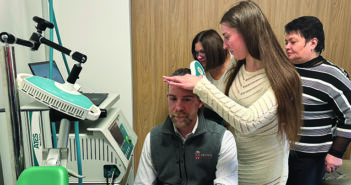Anti-racism and streamlined care go hand in hand in a new Rhode Island program.
Patrick McGann, MD, MS, was recruited to Brown last fall to create and lead a combined pediatric and adult sickle cell program at Rhode Island and Hasbro Children’s hospitals.
The sickle cell mutation arose in sub-Saharan Africa to protect against malaria, and most of the 100,000 Americans with the disease are Black. To address not only their illness but the structural racism and neglect they face as patients, McGann—a pediatric hematologist and associate professor of pediatrics and of medicine—has prioritized anti-racism and health equity as he builds this new program.
This interview has been edited and condensed for clarity.
How are sickle cell patients typically cared for in the US?
Most pediatric patients are treated by a pediatric hematologist with specific interest and expertise in sickle cell disease. But around when patients turn 21, their care is transitioned to adult providers—often hematologists or oncologists with limited training or experience in sickle cell disease who work within a cancer center. This adds insult to injury for patients who already feel stigmatized within the health care setting.
While some health care systems in the US have tight connections between pediatric and adult sickle cell programs, there are not any I’m aware of that have done what we hope to do: to create a physical Lifespan Sickle Cell Center that provides comprehensive care for anyone of any age.
How would a combined program benefit patients?
In pediatrics, we develop a strong relationship with a patient and their family over decades. And then at the very delicate age of 20, 21 or so, we ask these young adult patients to go to a new place, to develop a new relationship with this whole new team that they don’t know. With a combined program and a shared building, they will not have to rebuild that trust. Adults may interact with different members of the team, but there will be a continued presence of some members of the team and a shared physical space that they already have faith in.
The Lifespan Sickle Cell Center really could be a model, to break down barriers and allow for streamlined, lifetime care. It is feasible to build here in a small state with 300 patients, with hospitals that are connected. It will really be a one-of-a-kind place.
What changes are Rhode Island patients already seeing?
The adult and pediatric teams are beginning to merge. We’re having combined team meetings. We have a program coordinator who oversees all of our patients, regardless of age, who will become a constant face for patients. We’re in the process of hiring two community health workers and a sickle cell-specific research coordinator. We are creating clinical guidelines for patients of all ages. We are also trying to find an adult hematologist with interest and expertise in sickle cell disease, of which there are not many. We are hoping to find that unicorn.
We’re also working to develop a Patient/Family Advisory Council to inform us about how to improve things for the patients. We will talk to and listen to them about their experiences, especially when they don’t go well, to investigate why this happened and if these incidents may be related to race or racism. What I hope to do is to have accountability. There should be zero tolerance for racial stigma or inequitable care due to skin color or a diagnosis such as sickle cell disease.
What about sickle cell makes this necessary?
One of the most problematic symptoms is horrible acute pain due to blockage of blood vessels, referred to as a sickle cell crisis. These crises require pain medication, usually opiates, with guidelines recommending that patients receive pain medicine within 60 minutes if they come to the emergency department. That almost never happens, for lots of reasons. Some, because their pain might not be believed. Some because they’re not triaged appropriately, perhaps because of their skin color. The impression of many providers is that patients come to the hospital every time they have pain, and they’re often labeled as drug-seeking.
I’ve been speaking to nurses, social workers, doctors, medical students, anyone that will listen, to explain the challenges that sickle cell patients face and how you need to erase those biases. Medical education tells us that when patients have pain, they have a high heart rate and high blood pressure, they’re grimacing, they can’t really do anything else because the pain is so severe. But for sickle cell patients, this is part of their life. They’ve learned to cope with it. So usually, their vital signs are not abnormal.
Providers need to take patients at their word and treat their pain. The best thing you can do is listen to the patient, because they live in this body day in and day out.
What else are you doing to address racism?
We are identifying racism by name and addressing it actively and out loud within our teams, across the hospital, and with our patients. Talking about race and racism makes people uncomfortable. But when you don’t talk about it, it gets put under the rug. Anti-racism is at the forefront of what we do.
Thankfully, we have an amazing and growing team with champions in different places. Taneisha Wilson [RES’16 F’18 ScM’18, MD, an assistant professor of emergency medicine] has done extensive work to create an anti-racist emergency department at Rhode Island Hospital with specific initiatives focused on sickle cell patients. We have experts in pain management and palliative care, psychologists, social workers, specialized nurses and nurse practitioners, and leadership supporting this important and necessary program.




